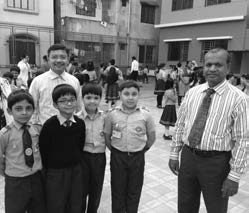Seventh-day Adventist education is the path to people’s hearts in Bangladesh, church leaders said.
“Our church in Bangladesh is basically schools,” said Milton Das, communication director for the Bangladesh Union Mission. “Education is the strongest medium to reach the people of Bangladesh. Where there is a church, there is a school.”
That first mission station, which paved the way for Adventist education to blossom in the country, was founded in 1906 by Lal Gopal Mookerjee and his wife, U.S. schoolteacher Grace Kellogg, in then-East Bengal.
Today, Adventist schools are thriving centers of influence across this country of 162 million people, with some 10,000 students attending 174 village schools, 10 city schools, and nine boarding schools. About 60 to 70 percent of the students are non-Adventist, and the figure rises to 99 percent in city schools such as the Dhaka Adventist Pre-Seminary school, which teaches 1,535 students in the country’s capital.
Adventist education is in high demand, with parents from various faiths wanting their children to learn Christian values, Das said.
“There are many more children waiting to go to school,” said Das, who also oversees Bangladesh Children Sponsorship Services, a department of the Bangladesh Union Mission that covers the tuition costs of 3,000 underprivileged children a year through partnerships with the General Conference, Adventist supporting ministry Asian Aid, and the Adventist Development and Relief Agency (ADRA).
Das himself received 16 years of Adventist education after an Australian woman paid his monthly tuition costs through Asian Aid. He said 90 percent of local church leaders were sponsored as children.
Shova Rani Bayen, 76, a retired schoolteacher, told of how she saw Adventist education change the lives of the Santali people living near Bangladesh’s border with Myanmar. She said the people wore nothing more than scant cloths to cover their genitals and ate all living creatures—including snails, rats, cats, and dogs—when she first arrived in the area with her husband, evangelist Narottom Bayen, in the early 1960s. The adults had no desire to live differently. “But then we opened a church school,” Bayen said. “Many of those children are now church workers, pastors, and evangelists.”

